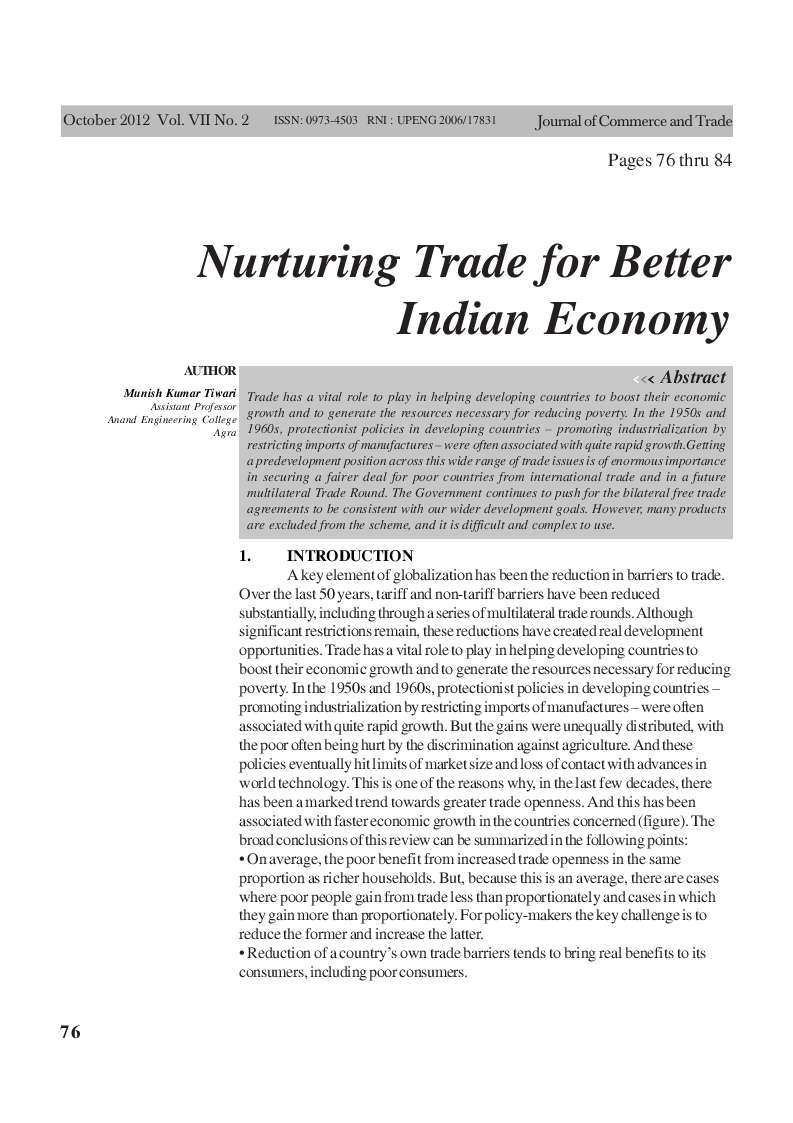Nurturing Trade for Better Indian Economy
DOI:
https://doi.org/10.26703/jct.v7i2.304Keywords:
Indian Economy, Globalization, Developing CountriesAbstract
Trade has a vital role to play in helping developing countries to boost their economic growth and to generate the resources necessary for reducing poverty. In the 1950s and 1960s, protectionist policies in developing countries – promoting industrialization by restricting imports of manufactures – were often associated with quite rapid growth.Getting a predevelopment position across this wide range of trade issues is of enormous importance in securing a fairer deal for poor countries from international trade and in a future multilateral Trade Round. The Government continues to push for the bilateral free trade agreements to be consistent with our wider development goals. However, many products are excluded from the scheme, and it is difficult and complex to use.
Downloads
References
UNCTAD 1996, Report on Least Developed Countries;
Crafts, Nicholas, March 2000, Globalization and Growth in the Twentieth
Century, IMF Working Paper;
Dollar, David and Kraay, Aart, March 2000, Growth is good for the Poor;
White, Howard and Anderson, Edward, 2000, Growth Vs Distribution: Does the Pattern of Growth Matter?;
Ravallion, Martin, July 2000, Growth and Poverty: Making Sense of the Current Debate;
Cornia, Giovanni Andrea, 2000, Inequality and Poverty in the Era of Liberation and Globalization, UNU/WIDER.
World Bank, 2000, Voices of the Poor Study. This was based on the experiences of more than 60,000 poor women and men in 60 countries, as background for the World Development Report 2000/2001.
The data in this box are drawn from: World Bank Policy Research Report: Confronting AIDS. Public priorities in a global epidemic and UNAIDS Report on the global HIV/AIDS epidemic, June 2000, Waking up to devastation.
UNESCO, 2000, Statistical Document Education for All Assessment. World Education Forum.
KPMG, 2000 The Impact of the New Economy on Poor People.
OECD, 2000, E-Commerce for Development: Prospects and Policy Issues.
The data in paragraphs 149-152 are drawn from IMF World Economic Outlook, September 2000.
Oxfam, June 2000, Tax Havens: Releasing the Hidden Billions for Poverty Eradication.
Cabinet Office Report, September 2000, Rights of Exchange: Social, Health, Environmental and Trade Objectives on the Global Stage.
McKay, Andrew, Winters, L Alan and Mamo Kedir, Abbi, June 2000, A Review of Empirical Evidence on Trade, Trade Policy and Poverty. CREDIT.
Collier, Paul and Dollar, David, March 2000, Can the World Cut Poverty in Half? And Dollar, David, May 2000, some Thoughts on the Effectiveness of Aid, Non-Aid Development Finance and Technical Assistance (nb. the 50% increase is based on constraining the allocation to India - if this is relaxed the figure increases to 90%).
Dollar, David & Burnside, Craig, 1988, Assessing Aid - What Works and What Doesn’t and Why, World Bank.
World Bank’s Country Policy and Institutional Assessment table 1998.
Foster, Mick, June 2000, Experience with Implementing Sector Wide Approaches, ODI
Dollar, David & Burnside, Craig, 1988, Assessing Aid - What Works and What Doesn’t and Why, World Bank.

Downloads
Published
Issue
Section
License
Copyright (c) 2012 Munish Kumar Tiwari

This work is licensed under a Creative Commons Attribution 4.0 International License.










